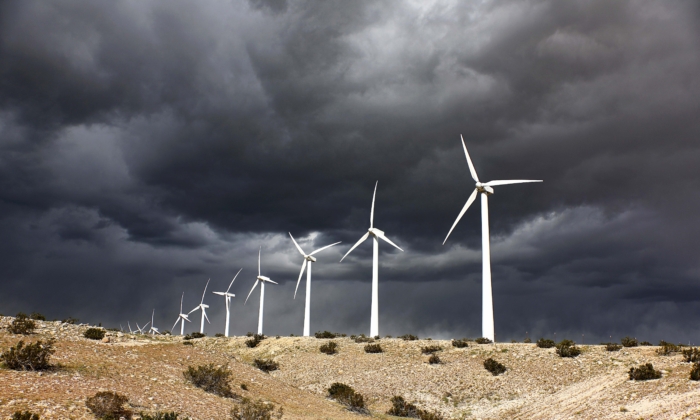


The retirement of fossil fuel-based power generators and the increasing adoption of renewable energy over the next decade puts America’s electricity reliability at risk, according to a recent report by power grid watchdog North American Electric Reliability Corporation (NERC).
There is “clear evidence of growing resource adequacy concerns over the next 10 years,” the Dec. 13 report states.
NERC is predicting “capacity deficits” in regions where future generator retirements will be higher than new replacements, thus leaving a part of demand unmet. “Wind, solar PV, and hybrid generation are projected to be the primary additions to the resource mix over the 10-year assessment period; this leads the continued energy transition as older thermal generators retire,” said the report.
Maintaining a reliable bulk power system through this transition period requires ensuring that the resource mix “satisfies capacity, energy, and essential reliability service (ERS) needs.”
“New wind and solar PV resources use inverters to convert their output power onto the grid, and the vast majority of resource inverters are susceptible to tripping or power disruption during normal grid fault conditions; this makes the future grid less reliable when more resources are inverter-based,” the report stated.
“Natural-gas-fired generators are essential for meeting demand; they are dispatchable at any hour and provide a consistent rated output under a wide range of conditions.”
Related Stories
The organization predicts energy risks in areas where the “resource mix” fails to deliver the required electricity supply due to energy constraints. For instance, a “period of low wind” can potentially create energy-constrained conditions if the resource mix does not contain necessary “dispatchable resources.”
These retirements can exacerbate the energy, capacity, or essential reliability service issues in regions at high and elevated risks of electricity supply shortages, the report says. In regions with a normal risk of shortages, the retirements can “potentially affect the projected sufficiency of resources.”
NERC warned that “overly rigid” environmental regulations and energy policies or measures that lack provisions for electric grid reliability can force generators to seek deactivation even when there is resource adequacy.
“This can potentially jeopardize the orderly transition of the resource mix. For this reason, regulators and policymakers need to consider effects on the electric grid in their rules and policies and design provisions that safeguard grid reliability.”
“While the outlook is improving for some assessment areas where resource additions and delayed generator retirements are alleviating previously identified near-term supply shortfalls, a growing number of areas in North America face resource capacity or energy risks over this assessment period,” the report said.
Commenting on the report, Kevin Kilty, a retired mechanical engineer, told Just the News that grid assessment organizations like NERC are usually careful when it comes to the language they use in their reports. “They use euphemisms that are sort of soft sounding, and they don't want to upset the political types. The political types are noisy and aggressive,” he said.
“They know that there are all kinds of problems coming unless they can figure out a way to solve them. And that's what this document looks like. It looks like they are now recognizing those problems, and they're trying to give everybody a warning.”
Mr. Kilty pointed to the energy crisis in the 1970s that resulted in long lines at the gas stations. At that time, America learned “not to discriminate against energy sources,” he said. As such, coal use began to spike until 2008, after which it started declining.
“Now we're back to discriminating against energy sources again, and putting way too much burden on natural gas.” While the NERC report advised boosting natural gas infrastructure, the Biden administration is currently opposing pipelines, he pointed out.
This included canceling the Keystone XL pipeline, issuing a moratorium on all oil and natural gas leasing activities in the Arctic National Wildlife Refuge, and revoking Trump-era orders that decreased regulations on federal land while expanding the ability to produce energy domestically.
President Biden implemented measures that artificially raised the regulatory costs of fossil fuel energy production. He also issued an executive order announcing a moratorium on new oil and gas leases on public lands or in offshore waters as well as reconsideration of federal oil and gas permitting and leasing practices.
The ongoing crackdown on fossil fuel energy is happening as the Biden administration’s electrification policies are expected to raise electricity demand.
President Biden intends to have 67 percent of new car sales be electric by 2032. The administration is also backing the electrification of appliances like stoves and heaters.
During a joint hearing of Pennsylvania and Ohio state lawmakers to discuss the PJM electric grid in November, Asim Haque, senior vice president for state and member services at PJM, warned that “there is a concern about a supply crunch at end of decade.”
PJM serves 65 million people across 13 states and Washington.
As the country transitions to renewable energy like solar and wind, there is a heightened risk to power reliability, he warned.
“A solar resource, while being able to perform extremely well during the summer, may not perform as well during the winter. How should the market evolve to account for that engineering fact?” Mr. Haque asked.
Beth Brelje contributed to this report.


